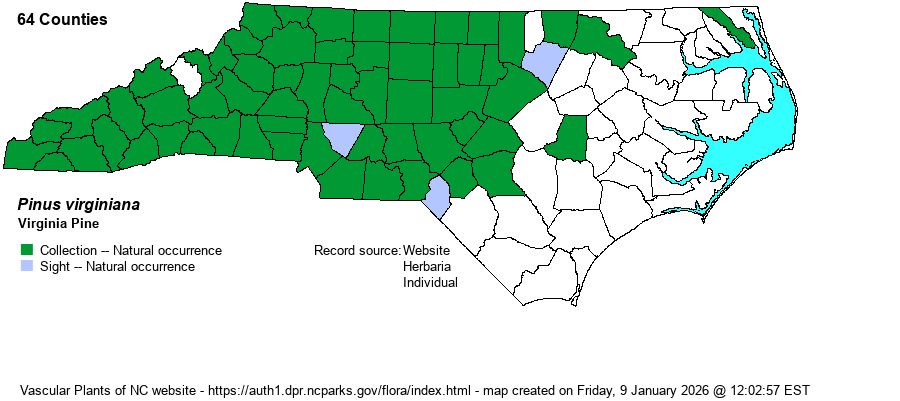| Author | P. Miller | |
| Distribution | Throughout the Mountains and Piedmont, certainly in every county in these provinces; also found in the Sandhills region, but barely into the Coastal Plain farther east.
This is a Mid-Atlantic species, occurring from NY (barely) southwest to MO, and south to southern AL. It apparently is not known from FL, and it is generally absent from the Coastal Plain south of VA.
| |
| Abundance | Abundant in the central and upper Piedmont. Frequent to common in the southern and lower (elevation) Mountains, more so in the far southwestern counties, but much less numerous in the northern half of the Mountains. Fairly common in the east-central Piedmont, east to about Caswell and Randolph counties, but uncommon toward the Fall Line (locally abundant in west-central Richmond County). Rare to uncommon in the Sandhills. | |
| Habitat | This species is characteristic of dry, often xeric, soil. It is a common old field succession species in the western half of the Piedmont. It grows in various other poor soils, on dry ridgetops and rocky slopes (especially south-facing ones) in the foothills and mountains, and in fire-suppressed disturbed ground in the Sandhills. |
| Phenology | Pollen is shed from March to May, and cones mature from September to November. | |
| Identification | As with several other pines in the state, this is a very familiar one to biologists. It is a small to medium evergreen tree, growing to about 50-60 feet tall, often in dense stands to the exclusion of other trees (until other trees mature in these successional pine stands). The needles are very short, averaging about 2-2.5 inches long, about as short as those of the Table Mountain Pine (P. pungens). As with that species, needles are in fascicles of 2. The cones are quite small, being elliptical in shape but only about 2-2.5 inches long, roughly the same length as the needles; Table Mountain Pine has quite round cones with strong prickles on the scales. The bark is quite unusual, as on older trees the older bark sloughs off to show an orangish color to the inner bark, not seen on our other pines. As the trees have such small needles, they look “scrawny” and malnourished, in comparison with other pines; the crowns are so open that there is seldom any cover for animals in the trees, nor any shade provided by these trees on the ground. Shortleaf Pine (P. echinata) has similarly small cones, but it has somewhat longer needles, and the trunks always consist of brown plates and never show the orange inner bank coloration. | |
| Taxonomic Comments | None
| |
| Other Common Name(s) | Of all of our native pines, this has the most lack of unanimity of a common name. Most references prefer Virginia Pine, as the scientific name is “virginiana”, and as the often used “Scrub Pine” is frequently in use by writers for the group of pines – such as Virginia, Shortleaf, Pitch, and Table Mountain – found in dry habitats. Other common name: Jersey Pine | |
| State Rank | S5 | |
| Global Rank | G5 | |
| State Status | | |
| US Status | | |
| USACE-agcp | | |
| USACE-emp | | |

